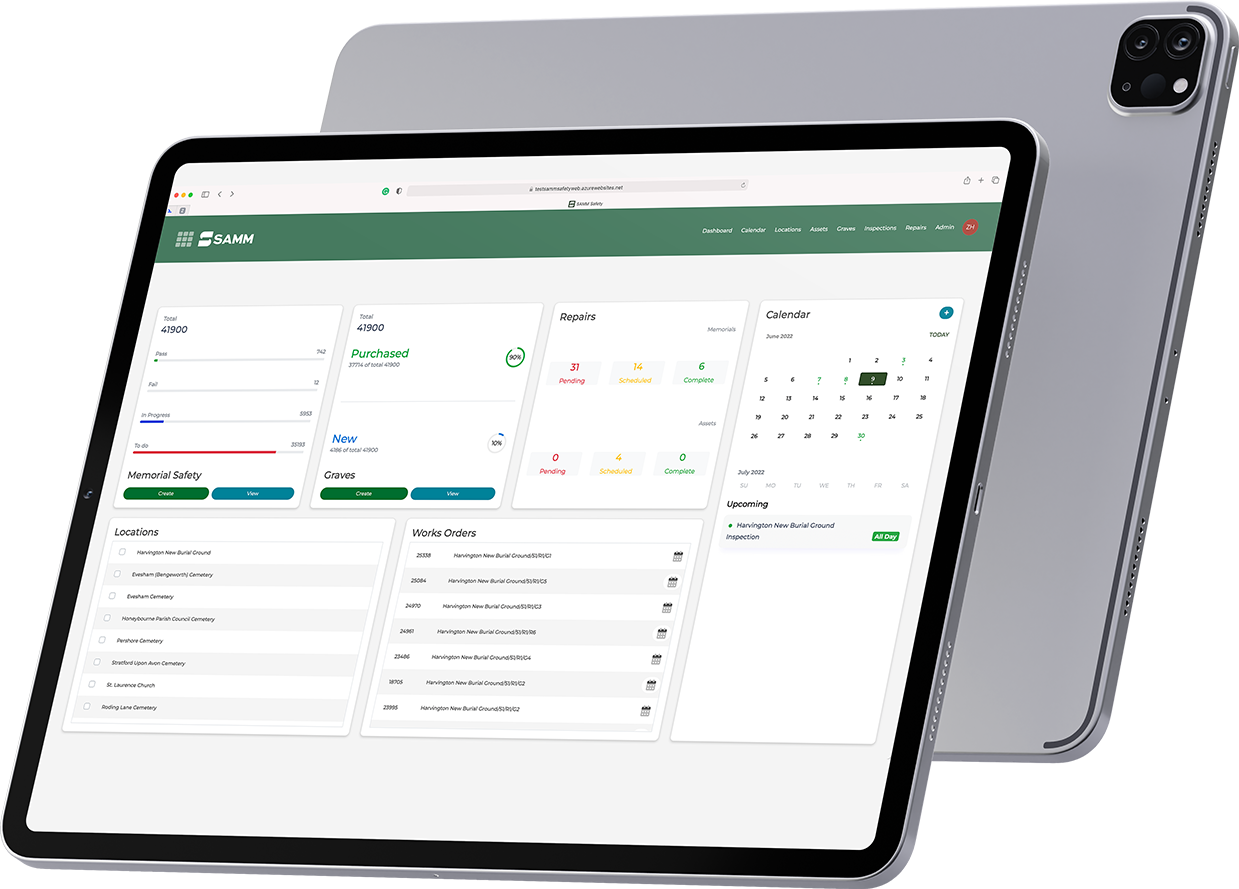Getting the layout right is more than drawing a plan. You need a trustworthy link between plots, records, permits, schedules and the work that happens on site. If you manage a council cemetery, a parish churchyard or a multi-site estate, the most useful cemetery layout software is the one that keeps locations, tasks and communications aligned, without adding admin.
This guide explains what good looks like, then shows how SAMM supports layouts through records, locations, routes and partner mapping that fits the way teams already work. (SAMM is built with bereavement-sector experts and supports cloud plus offline working.)
What layout means in day-to-day cemetery operations
A cemetery layout is not only a static map. It is a working model of your sites that supports:
- Accurate plot identification, with applicant and deceased details tied to each space. A quick search should find the right record, not a dusty plan in a drawer.
- Location-aware tasks, for example linking a memorial order to its grave location, or tying an inspection outcome to a plot that needs follow up.
- Scheduling and capacity, since a layout only helps if teams can see where and when they are due on site, and avoid clashes.
- Evidence and audit, because decisions about safety and memorial work must be traceable, with photos, documents and a history that stands up to scrutiny.
How SAMM supports layouts in practice
SAMM brings the moving parts of a layout into the daily workflow. The focus is on clarity for mixed-experience teams and confidence for managers.
Searchable grave records that travel with you
Search records in the office or in the cemetery, view inspection history, attach photos and documents, and keep everything in one place. This turns a paper plot plan into a living set of records that can be checked quickly and updated on site.
Location linking for memorial jobs
In SAMM Retail, each order carries its location. You can assign the grave, track permit submission and return dates, then book a fitting date and allocate teams in a shared calendar. This keeps the physical layout connected to permits and people so jobs run on time.
Route planning and follow-ups for safety
In SAMM Safety, managers plan routes, schedule teams and track remedial work in a shared diary. Outcomes and photos are visible immediately, which makes it easier to prioritise action by section or row.
Cloud access with offline working
Teams can capture inspections on Android or iOS tablets without a signal, then sync later. That means your layout and records keep moving even where connectivity is unreliable.
Integration with digital mapping partners
Where you need a visual map, SAMM works with chosen partners, including Pear Technology, to integrate digital mapping with inspection modules. This brings plotted sections together with the live inspection and records workflow, which reduces rework and helps teams find the right place first time.
Feature checklist for evaluating cemetery layout software
Use this list to compare options and to shape your brief.
- Record linkage that ties plots to applicant and deceased details, documents and photos.
- Permit and location management in the same workflow as orders and scheduling.
- Shared calendar and tasks so teams can see capacity and avoid clashes.
- Inspection routes, outcomes and follow-up tracking with an audit trail.
- Offline capture on tablets with secure cloud sync.
- Partner mapping integration so visual layouts sit alongside records and inspections.
- Onboarding and training that aligns your existing data to the new structure.
When a spreadsheet is not enough
Spreadsheets are flexible, yet they struggle to represent a layout that must drive work on the ground. They rarely connect to permits, teams or photos, and they do not offer an audit trail for safety decisions. A dedicated system brings structure, location context and evidence together so you can answer questions quickly and demonstrate good governance when needed.
How SAMM fits different teams
- Parish and small council sites can start with SAMM Safety for inspections and searchable records, then add location-linked job management in SAMM Retail when memorial volumes grow.
- Memorial masons use SAMM Retail to quote with instant supplier pricing, track permits and locations, assign teams and keep tasks on a shared calendar.
- Larger authorities benefit from roles and permissions, shared diaries and dashboards that make oversight easier across multiple cemeteries.
Explore modules: SAMM Safety and SAMM Retail.
Getting started with your layout in SAMM
- Import core records. The onboarding team helps reformat and clean data so you start with accurate information that reflects how you work.
- Set up locations and permits. Link orders to plots, capture permit dates and make schedules visible for the whole team.
- Plan a short pilot. Run a small inspection route or a limited set of memorial jobs to validate the workflow, then scale with confidence.
Pricing and support
SAMM offers tailored pricing that includes onboarding, training, support, licensing, software and data storage. This reduces change-management risk and helps teams realise value quickly.
Ready to see layouts working with live records and schedules
A short walkthrough will show how location linking, partner mapping, shared calendars and offline capture work together. Decide faster with a demo tailored to your sites and processes.
FAQs
Does SAMM include digital maps out of the box
SAMM supports layouts through location linking and integrates with digital mapping partners such as Pear Technology. Integration combines maps with inspection modules so on-site work stays simple.
Can we link memorial orders to specific plots
Yes. Assign the grave location to each order, track permit dates and schedule teams in a shared calendar in SAMM Retail.
Can field teams work without a data signal
Yes. Use Android or iOS offline mode in SAMM Safety to record inspections, photos and notes, then sync when back online.
Can SAMM import our existing records
Yes. The onboarding team imports grave records and helps align data so your structure reflects how your authority works.
How is pricing structured
Pricing is tailored to team size and usage, with onboarding, training, support, licensing, software and data storage included.


